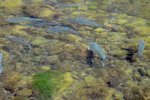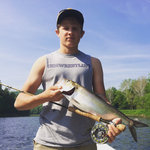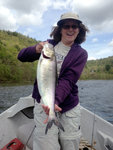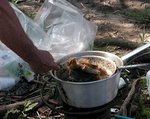, 0°
Wind: mph
The Delaware River is home to one of the largest American shad sea-to-river spawning rituals. These fish are considered anadromous; this means they live primarily in salt water and spawn in fresh …
Stay informed about your community and support local independent journalism.
Subscribe to The River Reporter today. click here
This item is available in full to subscribers.
Please log in to continue |




The Delaware River is home to one of the largest American shad sea-to-river spawning rituals. These fish are considered anadromous; this means they live primarily in salt water and spawn in fresh water. They are believed to return as close as they can physically get to their original birthplace, but as dams and floods change river configurations frequently, the fish adapt by swimming upstream to get as close as possible to where their homing senses take them.
As a temporary resident in Alaska, I witnessed salmon migrating up drainage ditches near supermarkets; shad will do the same in search of spawning grounds. Here, you will see shad by the thousands in the Delaware River and its tributaries between the third week of April and the second week of June. Once June hits, they have completed their spawning rituals and begin their decomposing process.
American shad have achieved the nickname of a “poor man’s salmon”; similar fishing styles and the anadromous characteristic has helped with this name. Fishing for them is an activity that has procured quite a cult following of fisherman all over the East Coast. Shad are native to the Atlantic Ocean, but were introduced to the Pacific Ocean in the 1800s and have flourished in some of the larger western rivers such as the Columbia and the Sacramento, where they also have a devoted following.
In the Delaware River we see three different types of shad, all part of the herring family: American, hickory and gizzard shad. American shad outnumber the others by hundreds of thousands. We see very few hickory and gizzards, but they do swim up the Delaware. All three types appear very similar, but each has unique dorsal fin patterns, and they differ in size and shape. American shad are the largest, at an average size of 20 inches and ranging from 2.5 to 6 pounds. The hickory and gizzard average one to three pounds.
A shad scale can be read like a palm, in theory. If you remove a scale from a shad and you know how to read it, you will be able to tell its age and number of spawning cycles. Less than 10% of American shad make it back to the ocean alive and return for a second spawning season, and next to none make it for a third.
Shad offspring remain in the fresh water of rivers for a few months as they gain size and strength enough to swim back downstream and into the ocean. In September and October, schools of thousands of fingerling shad can be seen swimming downstream to the ocean. These offspring are a huge contributor to the diets of resident fish in the Delaware and other rivers. Similarly, the decomposed bodies of the adults provide nutrients to the river. Without shad, the habitat would be very different for river biota of all kinds.
Fishing for shad on the Delaware River begins in April in the southern areas of the river, and they can be chased upstream over the following two months. The best tactic for shad fishing is to find a medium depth of the river’s main channel, preferably four to seven feet deep. A swift current usually helps to swing shad darts and flies in a downstream sweeping manner across the river channel. Standing in one location and casting out with four- to six-pound test line at a slight downstream angle will give you the right angle to actively fish the weighted flies or shad darts and keep them from getting stuck frequently.
Shad have very soft mouths and a unique method of eating your shad dart or fly; the take often feels like you hit a clump of weeds, but as you lift up on your six-foot-plus fishing rod, you will begin to feel the head shake. They will then put their broadside into the current and give you a great fight. Keeping pressure on these fish is a must to get them to the net; their soft mouths often help them shake the hook out during the fight.
So during this spring season, grab a pair of polarized sunglasses and some Croakies, go stand on one of the many bridges over the Delaware River and take a look down and try to spot the schools of shad swimming upriver. If you would like to try your luck at catching a shad, take a six-foot or longer medium-action spinning rod with a soft tip, set it up with a light reel and four- to six-pound test line and a pocket full of shad darts. Put some waders on and go find some shad fisherman and watch how they do it. Or, of course, you can always take a guided drift-boat trip to fish for shad. It is an easy style of fishing, once you get the feel for the current and weight of the darts.
[Evan Padua and his father Mike Padua run Sweetwater Guide Service, LLC, and guide fishing trips of all kinds on the Delaware River including for shad. Visit www.sweetwaterguide.com for more information.]
A population to be nurtured
Although American shad populations in the Delaware River have stabilized in recent years, they still have not recovered even to the levels prevalent in the 1990s, let alone the huge numbers prevailing 100 years prior to that. The chart above is Figure 22 from the 2016 “Delaware River Sustainable Fishing Plan for American Shad,” prepared by the Delaware River Basin Fish & Wildlife Management Cooperative. It shows the abundance of shad in the Delaware River as measured by a metric called Catch Per Unit of Effort (CPUE), from 1990 to 2015.
Shad for cooking?
Eating shad is a delicacy to some, feared by others, and well, mediocre to me personally. In fact, there is a joke that you should cook shad on a nice piece of cherry wood, bake it for hours, and upon removing the two from the oven, throw away the shad and eat the board.
There are a number of different ways to cook the actual fish, however they are quite bony and have an oily meat. People generally bake the fish or pickle it in hopes of dissolving a number of the smaller bones into the meat, then remove the remaining larger bones before consumption.
The other option is to eat the shad roe; the female’s egg sacs make up over two pounds of her body weight at times, and these sacks can be easily removed from the fish and thrown in a cast-iron pan and fried in oil. These roe sacks have a unique saltwater taste and plenty of protein, and can be seasoned however you like. But eating egg sacs obviously has more of an impact on the shad population than eating an adult, which has only a 10% chance of living to spawn again anyway. Since shad stocks are still struggling to return to former levels, fishermen hoping to preserve and enhance the population might want to release females with roe, even though regulations allow you to keep up to three American shad per day in the Upper Delaware.
Comments
No comments on this item Please log in to comment by clicking here